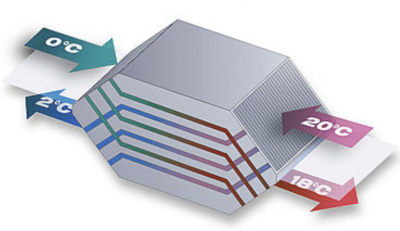Plastic heat exchangers are usually used inside MVHR units. For an air:air heatexchanger, there's not that much heat transfer needed across that plastic barrier (as the air conductivity is poor) so thin plastic is ok. Along the heat exchanger material we want low thermal conductivity, from the hot to cold end - so for this reason, plastic is preferred over metal. Piccy of I think what's in our MVHR core.
It does sound as though your unit is in permanent bypass then, so the heat exchanger core isn't being used. Some flaps open up inside the MVHR box, bypassing the core entirely. I suggest that you get a copy of the installation and user manuals, perhaps they can help. Certainly our own Vent Axia Sentinel Kinetic can be easily told not to use summer bypass ever, irrespective of temperature sensors - it's a user adjustment not installer on ours.
What unit do you have ?
Posted by: @roblFor an air:air heatexchanger, there's not that much heat transfer needed across that plastic barrier (as the air conductivity is poor) so thin plastic is ok.
Along the heat exchanger material we want low thermal conductivity, from the hot to cold end
Can I ask what is the purpose of a heat exchanger?
@dandee A heat exchanger is used to transfer (in this instance anyway) warmth from the air that is about to be exhausted from the house (stale air) and that energy is used to heat the colder air being introduced to the house as fresh air from outside before it is distributed in the property. Basically a surface conducts the heat from the exhaust air and applies it to the incoming fresh air. Regards, Toodles.
Toodles, he heats his home with cold draughts and cooks his food with magnets.
Posted by: @fazelCan I ask what is the purpose of a heat exchanger?
That question is a great leveller. 🙂
It shows the rest of us how we quickly descend into the technical depths!
In general terms a heat exchanger transfers heat between two fluids (liquids or gasses), whilst keeping those fluids separate.
The radiator of a car is a simple heat-exchanger.
Heat from the engine is passed into cooling water.
That water is pumped through the radiator, which has thin metal fins to transfer the heat into a stream of air.
The water and the air don't come into direct contact.
Within a household ventilation system (MVHR) there is a heat exchanger with a much larger surface area.
Hot, humid, sticky air is sucked out of shower/bath-rooms and kitchens.
As it passes through the heat exchanger, the heat is passed to fresh air being drawn in from outside the home.
The separation between the two streams of air means that the cooking smells from the kitchen, and the humid atmosphere from a shower cannot pass into the fresh air.
Save energy... recycle electrons!
Posted by: @fazelPosted by: @roblFor an air:air heatexchanger, there's not that much heat transfer needed across that plastic barrier (as the air conductivity is poor) so thin plastic is ok.
Along the heat exchanger material we want low thermal conductivity, from the hot to cold end
Can I ask what is the purpose of a heat exchanger?
Ohh boi, it was a rhetorical question, see the bold highlighted statements about the heat exchanger.
Placing the quoted phrases in a bold font was too subtle for me @dandee
I'd need at least one smilie to grab my attention. 🙂
As a member of a Community Energy group, I'm not daunted by receiving very basic questions from members of the public (or politicians!).
Save energy... recycle electrons!
The heat exchanger material conductivity is actually a compromise. Through the material, the thin way, we want high conductivity. Along the material there is a parasitic loss mechanism, for which we want low conductivity. Plastic is a better compromise of these two competing requirements than Aluminium is for an Air:Air heat exchanger - as the air boundary layer has an effective conductivity which is quite low there's little point using Aluminium or Copper as it won't improve performance noticeably, while the parasitic losses would shoot up. For a water:water heat exchanger plastic would be a poor choice, and a metal would generally be chosen.
Discussion on a forum is actually a compromise. Through this medium we actually want high transmissivity of information. Along the discussion there is a inherent loss-mechanism, through which we experience periods of low communication...
... which is why @robl is still posting coherent technical descriptions of the physics behind the design of heat exchangers, 25-hours after @dandee told us it was a "rhetorical question". 🤣
But hey... it's Friday!
and I've just enjoyed reading an erudite explanation of parasitic losses. 😉
Save energy... recycle electrons!
Posted by: @roblThe heat exchanger material conductivity is actually a compromise. Through the material, the thin way, we want high conductivity. Along the material there is a parasitic loss mechanism, for which we want low conductivity. Plastic is a better compromise of these two competing requirements than Aluminium is for an Air:Air heat exchanger - as the air boundary layer has an effective conductivity which is quite low there's little point using Aluminium or Copper as it won't improve performance noticeably, while the parasitic losses would shoot up. For a water:water heat exchanger plastic would be a poor choice, and a metal would generally be chosen.
Sorry I'm struggling to understand this. I'll try to play back what I've got from you: We want to conduct air from the outgoing (warm) side to the incoming (cold) side. For this, we need a thin material that has high conductivity in the perpendicular direction, to allow transfer across the interface. However, because the air passage is quite long, we don't want the material itself to be leeching heat away from the warm air and transporting it laterally along the length of the material: we want it transfering perpendicularly across the interface only. So plastic is better for this.
However, I still don't feel like I really "grok" the explanation. Nor can I explain why we want plastic for air:air but metal for water:water.
If you don't want to explain it again (which is totally understandable!) do you have any suggestions for where I can look this up?
ASHP: Mitsubishi Ecodan 8.5kW
PV: 5.2kWp
Battery: 8.2kWh
@scrchngwsl You have already noted that for efficient counter-current heat transfer, you want to avoid heat transfer within the fluid streams. In each fluid, there is a laminar boundary layer which constitutes the major resistance to heat transfer to the interface. There is then the heat transfer perpendicular through the exchanger surface as well as that within the plane of the exchanger surface. The exchanger plate thickness is minimised (and length of exchanger maximised) to maximise flow across plate rather than along it. Flux through plate is proportional to delta-T across plate surface while flux within plate is proportional to temperature gradient along plate.
However, the boundary layer in air poses at least an order of magnitude more resistance than water and heat flux through an air boundary layer is going to be correspondingly lower. At this lower heat flux, the delta-T across the plate will be also correspondingly reduced but the gradient along plate will not (I still want to shift that amount of heat in that distance). The lateral flow of heat within the plate will therefore start to dominate, particularly if the plate has a high conductivity. I am therefore willing to use a lower conductivity plate material (which will result in a higher delta-T) to shift the balance back towards transfer across plate.
It was just yesterday that James posted
Posted by: @jamespipeHello! I'm not a tech-savvy person. I'd like the moderators and other members to dumb down the complex subjects to my level. 😀
Have we achieved that yet, James? 😉
Save energy... recycle electrons!
@ronin92 thanks a lot, that cleared it up for me!
ASHP: Mitsubishi Ecodan 8.5kW
PV: 5.2kWp
Battery: 8.2kWh
- 26 Forums
- 2,113 Topics
- 46.4 K Posts
- 51 Online
- 3,410 Members
Join Us!
Latest Posts
-

RE: Wood burner with ASHP - direct air?
I love the new fully Viking look... best personal avata...
By Mars , 5 hours ago
-
RE: No-code, plug-and-play monitoring for your heat pump
I think I have found “The One!” Waveshare ESP32-S3-POE-...
By Grantmethestrength , 20 hours ago
-
RE: Buffers, hot water and cooling
@prunus, @jamespa is correct, but removing the buffer ...
By Brendon Uys , 1 day ago
-

@downfield and @toddles, this isn’t in the settings cur...
By Mars , 2 days ago
-
RE: Homely launched for Grant Aerona ASHP control
I haven't bought the Aerona Smart Controller (£700!) bu...
By Prunus , 2 days ago
-
RE: Antifreeze top up for my heat pump - is this a rip off?
For the record, Grant supply ethylene glycol for their ...
By Prunus , 2 days ago
-

RE: Compressor attempts start but fails - Nibe Fighter 2005 8kW
@skyefarmer amazing. Well done!
By Mars , 2 days ago
-

RE: Say hello and introduce yourself
Hi @topher - you might be interested to see this very r...
By Transparent , 3 days ago
-
RE: Air source heat pump roll call – what heat pump brand and model do you have?
Ebac 5kw - Monobloc R32. Developed and made in UK - Mit...
By marcinwloch69@gmail.com , 4 days ago
-
RE: Is a Valliant Inline 6kW heater a BUS buster?
Just another thought - it might be worth thinking about...
By JamesPa , 4 days ago
-

RE: BUS Grant: removal of all other fossil fuel heat sources
@rikiarn - just have a think as to how much it will cos...
By Transparent , 5 days ago
-

Don't do much digging around.That's best left to the pr...
By Transparent , 5 days ago
-
Hi all, I was wondering if anyone had an idea of how th...
By Wh0am3ye , 5 days ago
-
RE: EBAC re-entering the ASHP market in 2023
@toodles confirm i have Ebac 5kw ASAP + homely and it w...
By marcinwloch69@gmail.com , 5 days ago
-
RE: Compute heat loss from energy used
@jamespa Ebac must be similar to Mitsubishi as they buy...
By marcinwloch69@gmail.com , 5 days ago
-

@pie_eater I have been thinking of adding cooling to my...
By TechnoGeek , 1 week ago
-
RE: Victorian Semi Retrofit / Extension ASHP and UFH Advice
Agree, but you may have a hard time convincing them, as...
By JamesPa , 1 week ago
-
RE: Seal the Deal: Don't Let Your Heat Pump Leak Energy
Hi - fyi - there's a dead image link in the 'Optimal In...
By seatonian , 1 week ago
-

RE: Ripped Off: How UK Homeowners Are Paying Gas Prices for Wind Energy
@chandykris Horses and beggars…. 😉 Toodles.
By Toodles , 1 week ago
-

RE: Cleaning up after gas meter removed
@agentgeorge Likewise in the loft space; we have 300mm ...
By Toodles , 1 week ago





